
Government executives on AI Surveying how the public sector is approaching an AI-enabled future
12 minute read
08 November 2019
As government uses artificial intelligence more, how can the experiences of early adopters guide other public sector organizations?
As one of the hottest technologies of recent years, artificial intelligence (AI) has started penetrating both the US public and the private sectors—though to differing degrees. While the private sector seems bullish on AI, the public sector’s approach appears tempered with more caution—a Deloitte survey of select early adopters of AI shows high concern around the potential risks of AI among public sector organizations (see the sidebar “About the survey”). The findings in this study show the approaches and experiences of these early adopters of AI in the public sector. They give a peek into how public sector organizations are approaching AI; and how the approaches, in many cases, differ from those of their private sector counterparts.
Learn more
Read more about AI in government
Explore the Government and public services collection
Download the Deloitte Insights and Dow Jones app
Subscribe to receive more related content
AI is not completely new to the public sector. The first AI contract was awarded in 1985 by the US Social Security Administration,1 but the technology still wasn’t advanced enough to become common in the following decades. Now, the growing ubiquity of digital technologies, advances in the ability to store and analyze massive amounts of data, and exponential growth in processing power seem to finally be fast-tracking AI into the mainstream.
This growing usage is reflected in the AI initiatives being undertaken by public sector organizations across levels. For instance, in February 2019, US President Donald Trump signed an executive order to create the American AI Initiative, which aims to prioritize and guide AI development in the United States.2 This builds on other federal AI initiatives, such as the Select Committee on AI.3 At the state level, the government of New Jersey has set up an innovation training platform to educate government workers about new technologies such as AI and blockchain.4
As we have documented in previous studies,5 the number of AI use cases in the public sector has increased manifold. As AI usage in the public sector continues to grow, we sought to answer questions such as, how do early adopters in the public sector perceive AI? What approaches are these early adopters pursuing? Do these approaches differ from those of the private sector?
The survey results reveal that the public sector early adopter respondents generally feel positive about their early AI experiences. They are using AI to augment human capabilities, generating demand for newer skills. However, many still lag other industries due to reasons such as lack of investment and skilled talent. Also, they tend to be understandably more cautious than other industries due to ethical risks associated with AI. This caution has led to new ways of developing AI solutions in the public sector, such as prototyping AI projects in controlled environments and codeveloping AI solutions with partners.
About the survey
To gain insights into the experiences of early users of AI, Deloitte surveyed 1,100 executives from US-based organizations across 10 industries currently using AI, in the third quarter of 2018. About 10 percent of the respondents were from the federal government, state government, higher education, defense, international donor organizations, public health and social services, public transportation, and security and justice—a collection of entities we refer to as “public sector.” This sample allowed us to examine how the AI approach of early adopters in the public sector compares with that of private industry.
The survey required the respondent’s organization to be using at least one AI technology and to have built (or be building) at least one AI prototype system or full implementation/production system. Also, respondents were required to be knowledgeable about their organization’s use of AI.
What is artificial intelligence?
AI technologies are defined as those that can perform or augment tasks, better inform decisions, and accomplish objectives that have traditionally required human intelligence, such as planning, reasoning using partial or uncertain information, and learning.6 AI technologies include robotic process automation, natural language processing, machine learning, computer vision, speech recognition, deep learning, and intelligent robotics.
Early adopters believe AI can be critical to organizational success
Many early adopters in the public sector expect AI technologies to become increasingly important in the coming years. About 57 percent of early adopters surveyed believe that AI is “very” or “critically” important to their organization's success today, and 74 percent of respondents believe it will be in the next two years (figure 1).
Some of the most popular AI uses cases in the public sector focus on quality control issues (detecting defects and finding errors in software code), workforce management (recruiting and training), and cybersecurity (figure 2).
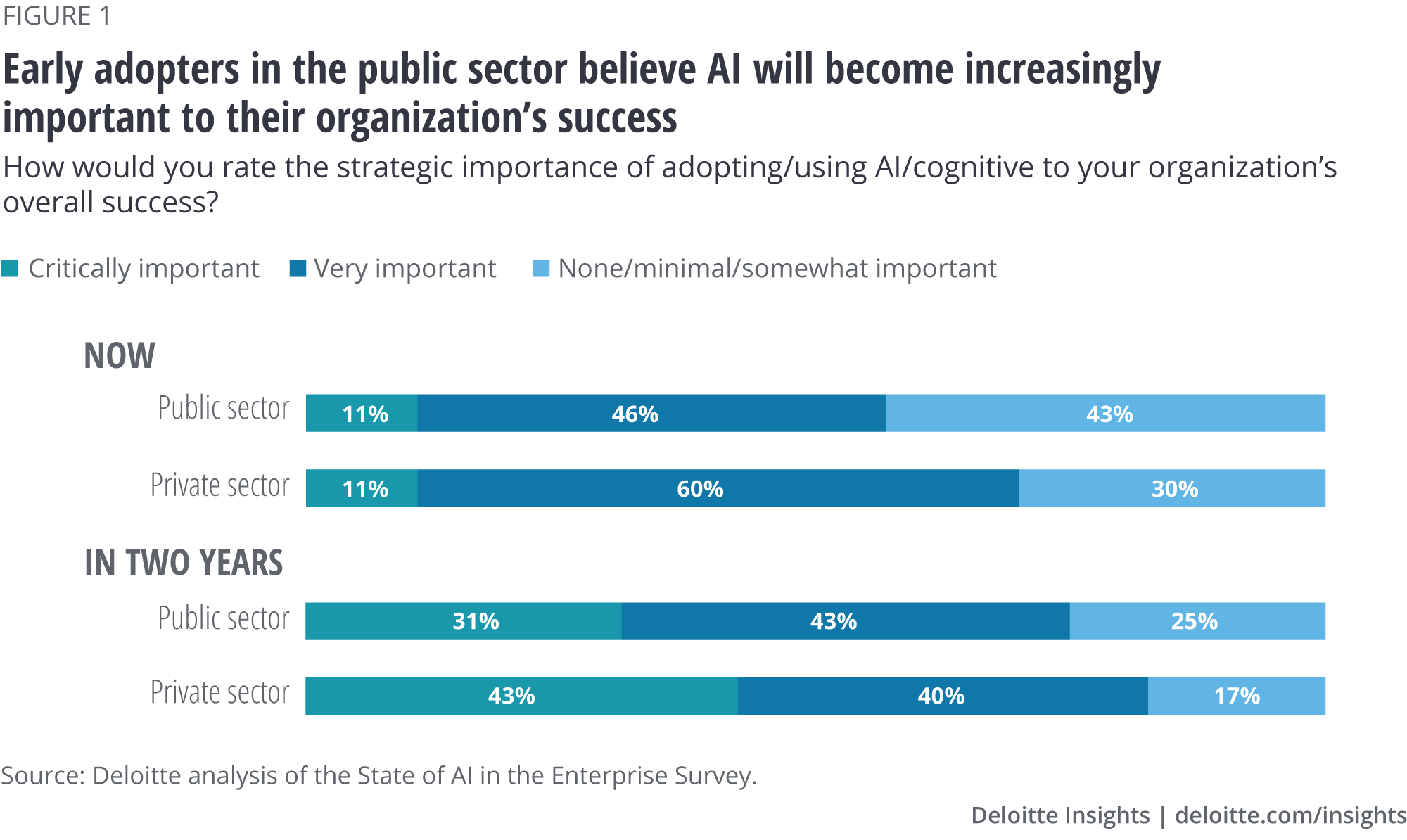
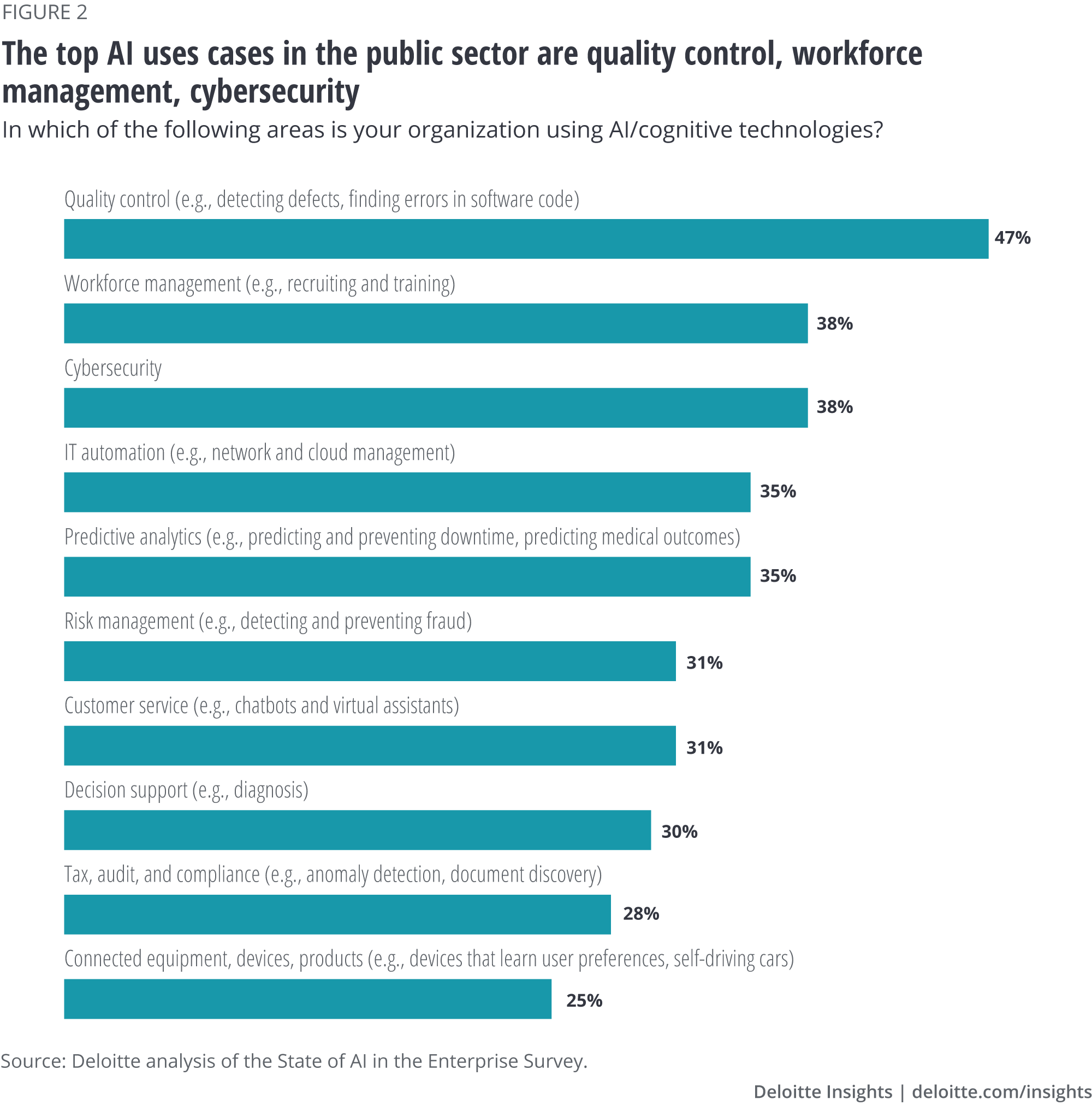
Early adopters see AI as a way to augment human capabilities
The survey results suggest that AI is primarily being used to make the work of humans more effective rather than automate it altogether. Freeing up workers to be more creative by automating tasks has been identified among the top three benefits of AI by early adopters surveyed, while reducing headcount through automation is near the bottom (figure 3).
One area where AI is being used in many governments to free workers from repetitive tasks is customer service chatbots. North Carolina’s Innovation Center, or iCenter, uses chatbots to aid internal IT help desk personnel. The iCenter found that 80 to 90 percent of the IT help desk tickets were for password resets. By leveraging chatbots for such routine requests, the iCenter is allowing workers to deal with more complex issues.7
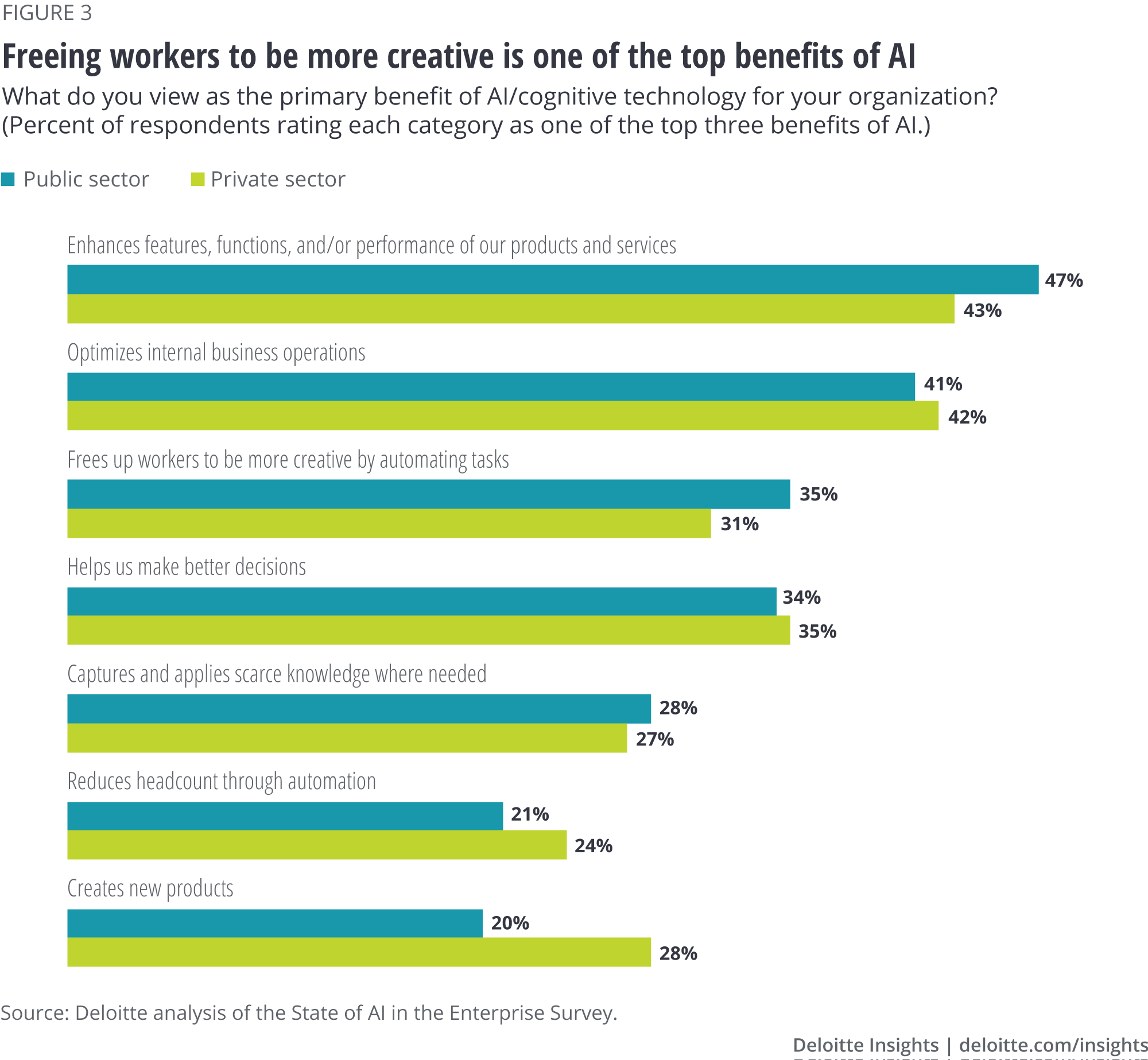
As AI gets integrated into public sector organizations and routine tasks are automated, workers will need to learn to work with these technologies or will need to perform new and different work. As many as 76 percent of early adopter respondents in the public sector said human workers and AI will augment each other to produce new ways of working (figure 4).
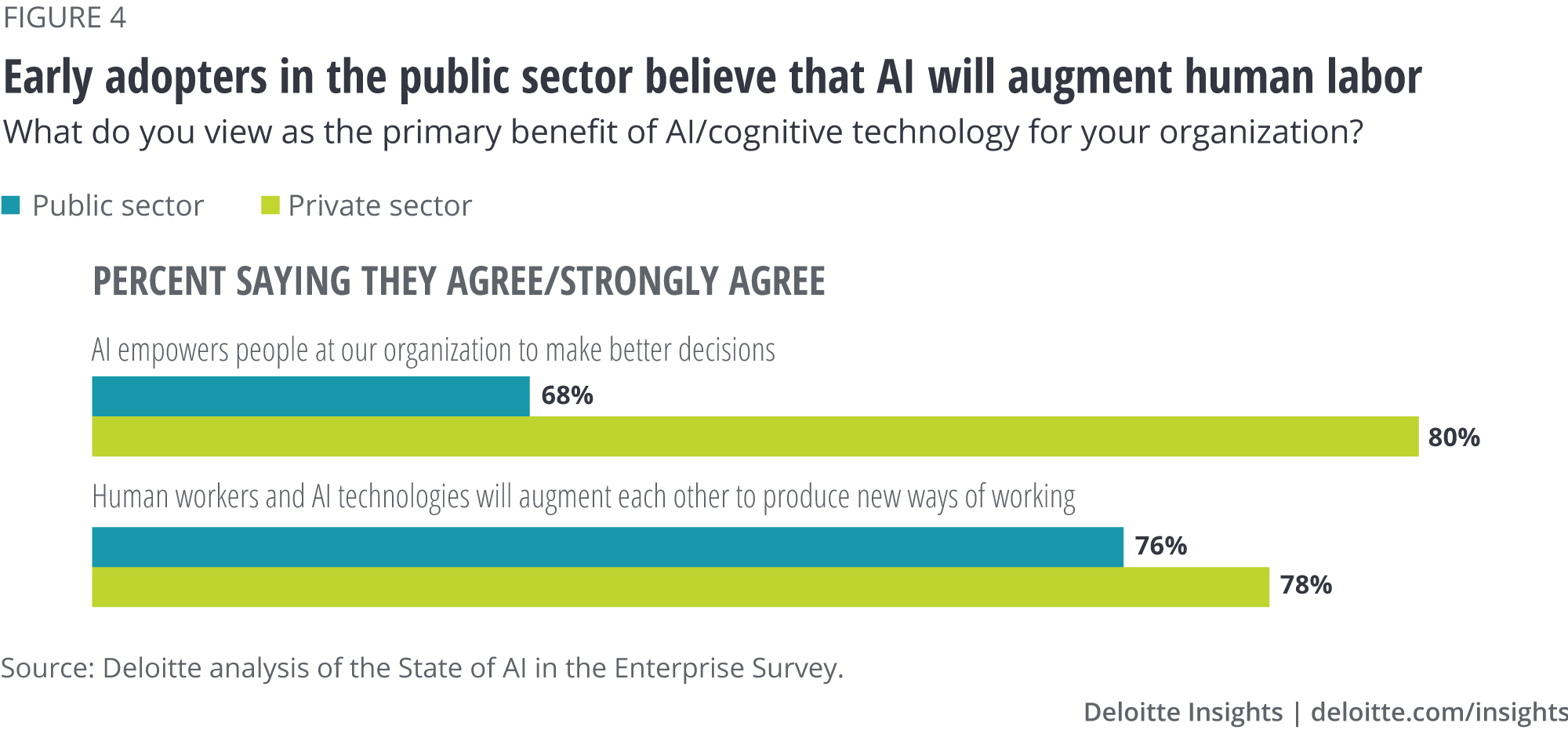
The use of AI is already generating demand for new skills in the public sector beyond technology and technical skills. While 34 percent of early adopters surveyed are looking for software developers and 23 percent for data scientists, a sizable 30 percent cite the need for business leaders, and 23 percent for change management experts (figure 5).
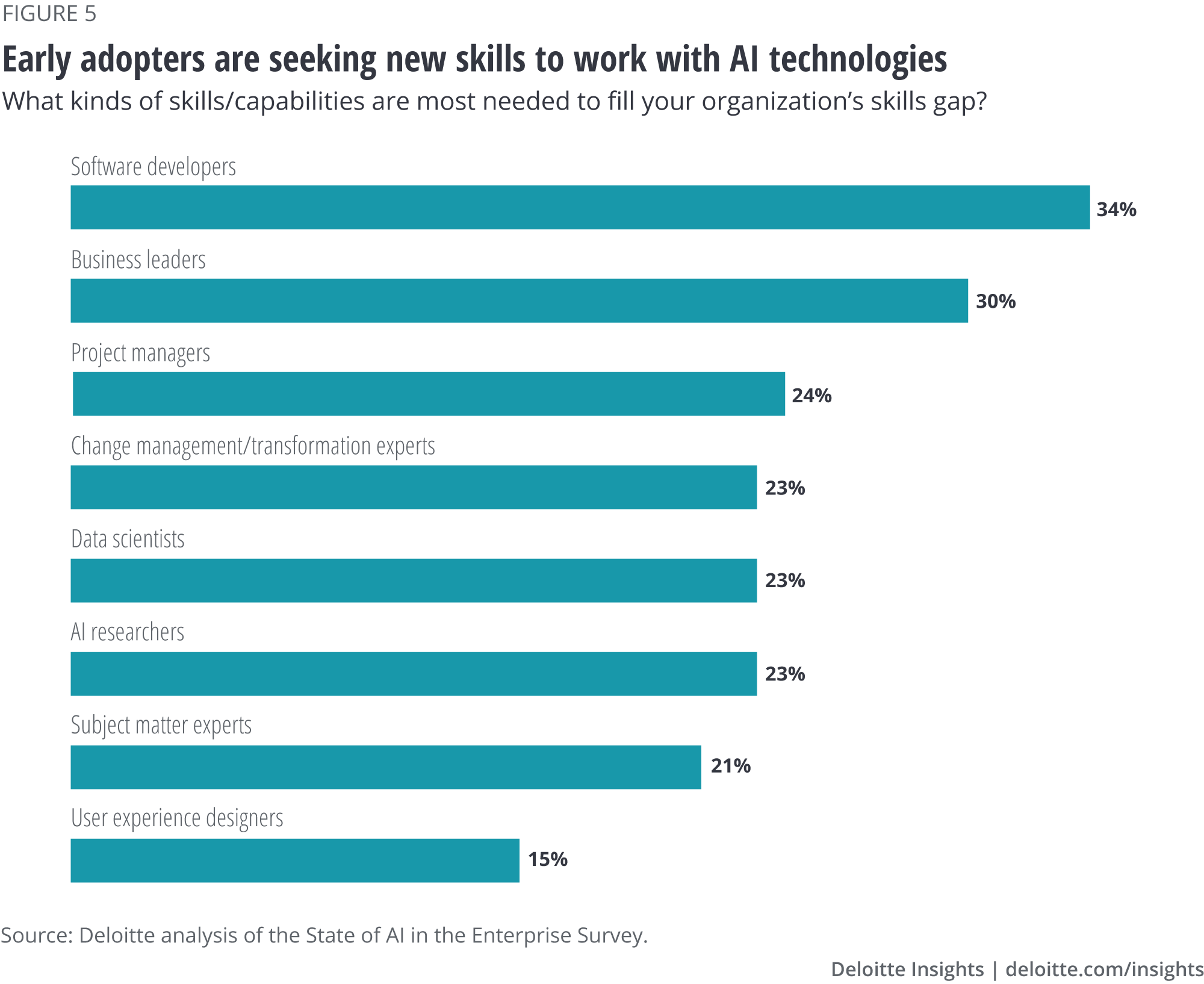
The public sector lags other industries in AI adoption
Compared with other industries, the public sector has the highest proportion of “starters,” those at the beginning of their AI journey, and the lowest proportion of “seasoned,” or experienced, AI adopters. (See the sidebar “Starter, skilled, and seasoned adopters of AI” to learn more about this classification.)
Starter, skilled, and seasoned adopters of AI
Some adopters of AI are further along in their efforts than others. To aid our comparison, we identified three distinct segments at different levels of maturity. The “seasoned” (24 percent of all respondents) is the most experienced cohort, at the leading edge of AI adoption maturity. They have undertaken a number of AI production deployments; they also report that they’ve developed a high level of expertise in selecting AI technologies and suppliers, identifying use cases, building and managing AI solutions, integrating AI into their IT environment and business processes, and hiring and managing AI technical staff. In the middle is the “skilled” cohort (45 percent). They have launched multiple AI production systems but are not yet as AI-mature as the seasoned adopters. They lag in their number of AI implementations, level of AI expertise, or both. At the low end of the spectrum are “starters” (31 percent), which are just dipping their toes into AI adoption and have not yet developed solid proficiency in building, integrating, and managing AI solutions.8
Only 14 percent of public sector adopters surveyed are classified as seasoned, whereas 45 percent are still classified as starters. Meanwhile, in industries leading the way in AI such as financial services and technology, media, and telecommunications, around 30 percent of respondents are classified as seasoned AI adopters (figure 6). However, some pockets in the public sector, such as defense and national security, are outliers, since they have been developing and using AI for many years.
The public sector is also behind other industries in integrating AI technology into business processes and the IT environment, and finding the right use cases for AI (figure 7). The one area in which the public sector is on par with other industries is selecting AI technologies and technology suppliers, with about 44 percent of respondents from both sectors saying they were mature in this area (figure 7).
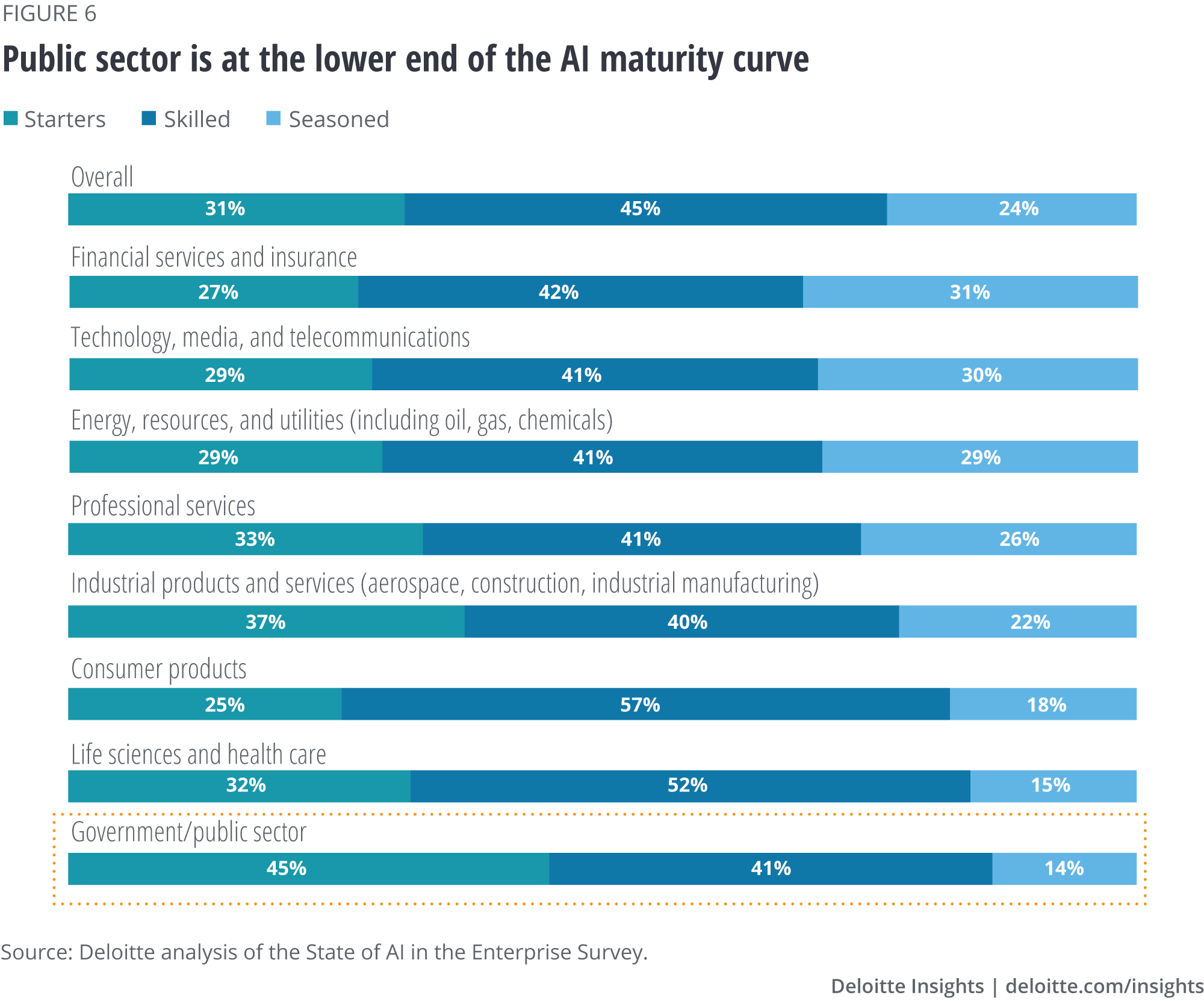
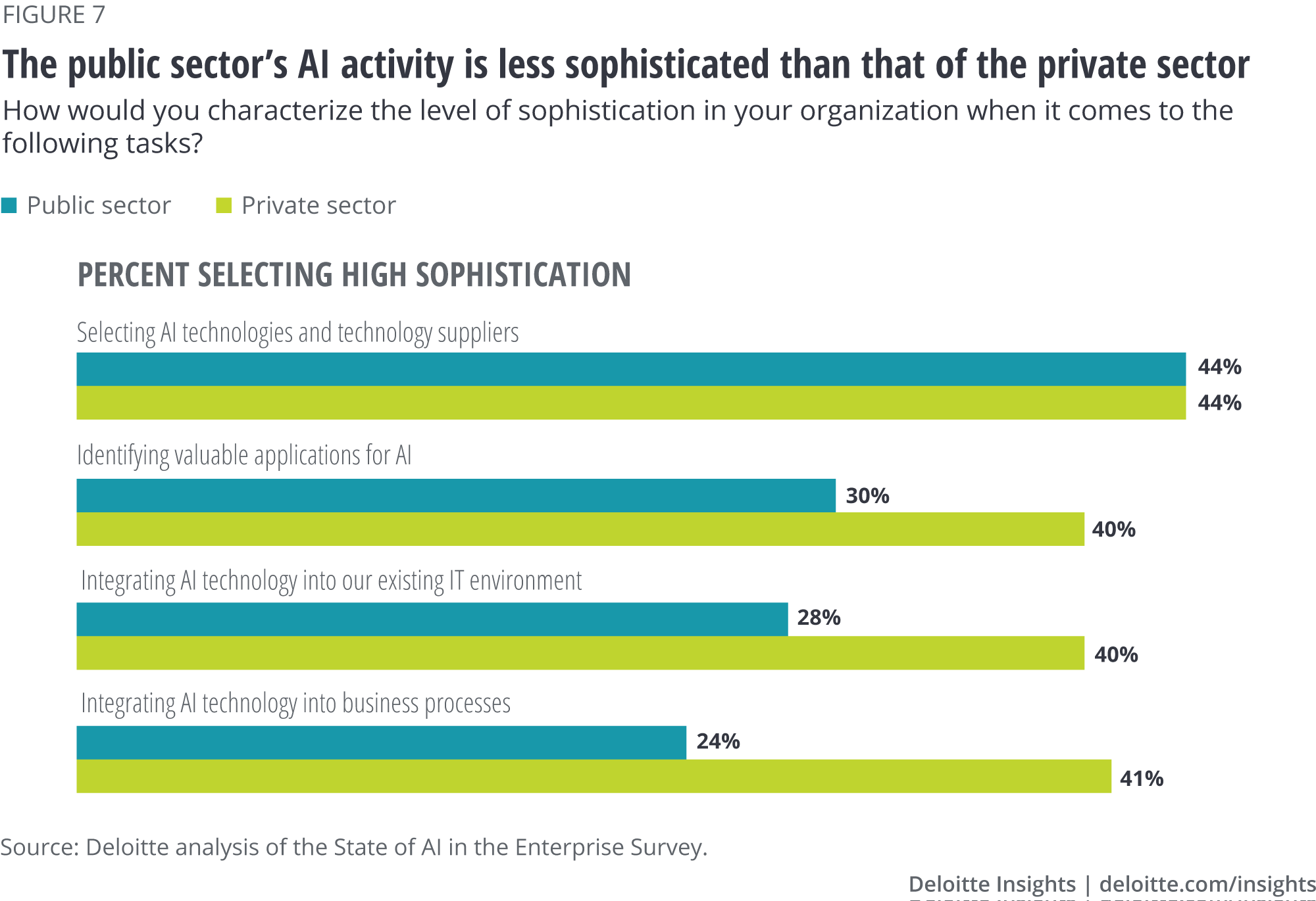
Lack of investment and a skills gap could hinder adoption of AI
The survey shows that, among early adopters across industries, the public sector has both the lowest level of AI investments and lower return on investments from their AI initiatives (figure 8).
The low returns on AI investments could be due to a focus on improving citizen services rather than cost savings. The low investment itself could be attributed to the high maintenance costs of government legacy systems. In 2018, the US government allocated 78.5 percent of its US$95.7 billion IT budget to operating and maintaining legacy systems.9 At the same time, CIOs of the most innovative private sector organizations allocated a little less than half of their budgets (47 percent) to operations, with the remaining amount going into business enhancements (27 percent) and innovation and growth (26 percent).10
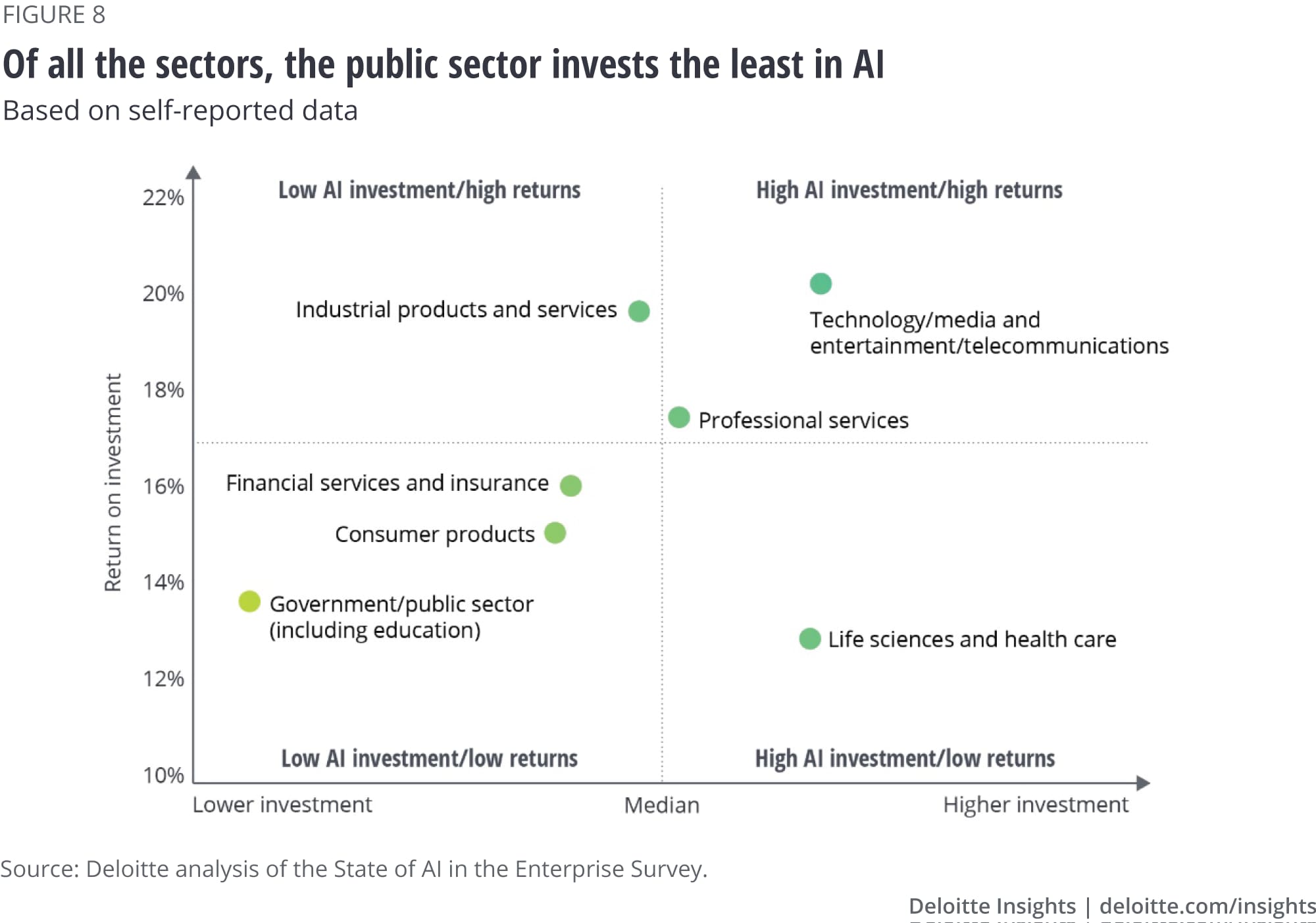
Nevertheless, most public sector respondents plan to increase investments in the future. Some 40 percent of respondents said their organization plans to increase investment by more than 10 percent, and only 4 percent said their organization plans to reduce investment, implying an increased investment focus on AI technologies (figure 9). However, these numbers are still lower than in the private sector, as 55 percent of private sector respondents said their organization plans to increase investment by more than 10 percent, and only 1 percent said their organization plans to decrease investment.
Another factor seeming to hold back adoption in the public sector is the lack of needed skills. As much as 71 percent of respondents cited the skills gap as a barrier—ranging from moderate to extreme—to advancing AI projects in their organization.
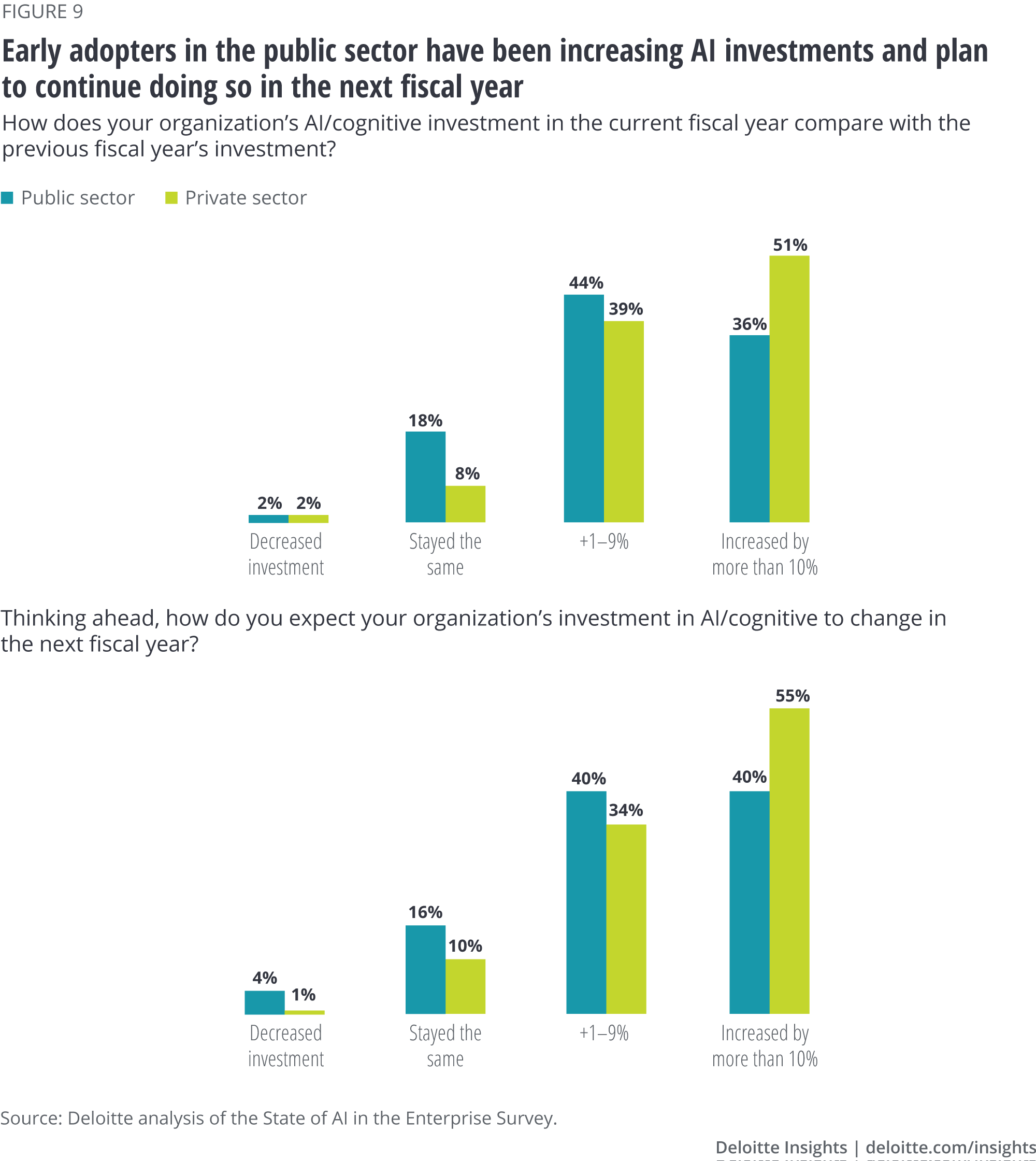
Cybersecurity and ethical risks are a major concern
About 46 percent of respondents from the public sector said they have “major” or “extreme” concerns about the potential risks associated with AI (figure 10).
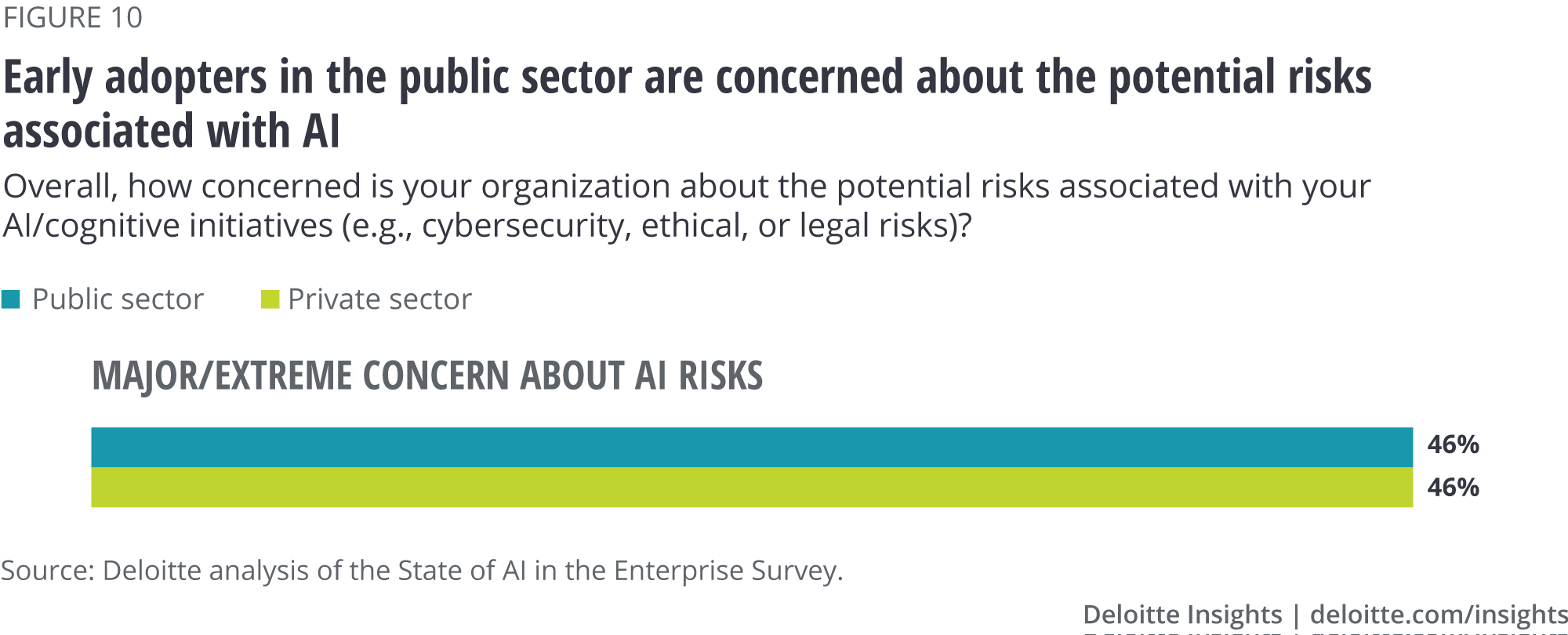
Of the different types of risk, ethical risk is the second-highest concern cited by public sector early adopters surveyed, but the lowest-ranked concern for early adopters in other industries (figure 11). Further, recent media reports highlight how government concerns around ethical risks of AI are slowing and, in some cases, even halting the use of some AI technologies. San Francisco, for example, was the first major US city to block the use of facial recognition technology. The decision was rooted in concerns about the invasion of citizen privacy as well as potential racial bias.11
The concerns around cybersecurity vulnerabilities are not surprising, considering the increasing number of cyberattacks on government systems. In 2017 alone, federal civilian agencies reported more than 35,000 security incidents.12
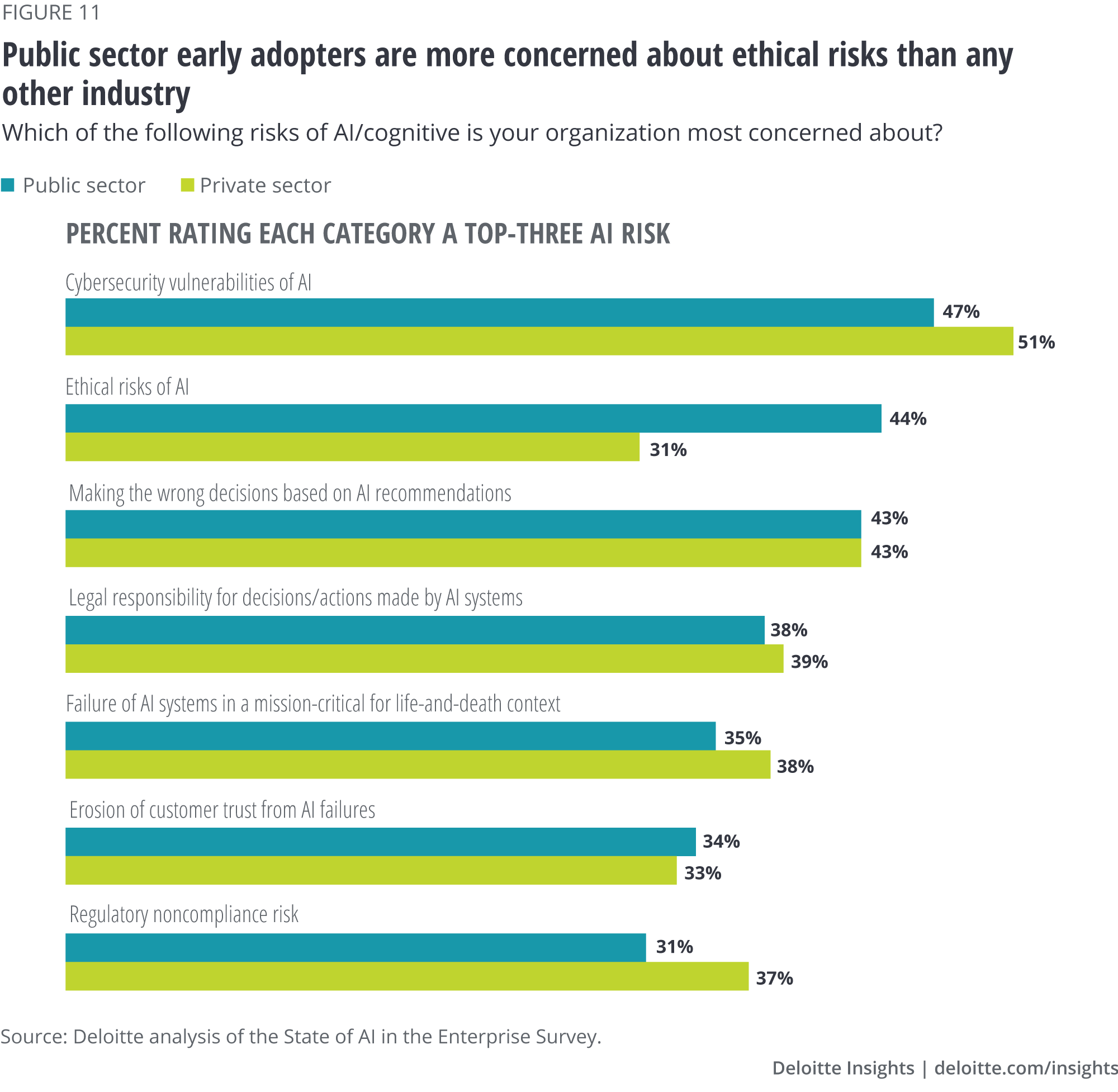
Early adopters are trying to find ways to balance AI benefits and risks
While public sector early adopter respondents are enthusiastic about the potential of AI technologies, they are reportedly constrained by resource shortages and are concerned about the risks associated with these technologies.
However, public sector organizations are making efforts to overcome these hurdles and move ahead on their AI journey. Such efforts include:
- Codevelopment with partners: Our survey found public sector early adopters to be more inclined than the private sector to codevelop AI solutions with partners (figure 13)—possibly due to the advantages of tapping into market expertise and bringing in new capabilities to mitigate technology risks. In fact, the Interagency Select Committee on Artificial Intelligence, which advises the White House on AI research and development priorities, proposes this approach.13 Working with industry partners may require capabilities within government for auditing algorithms.
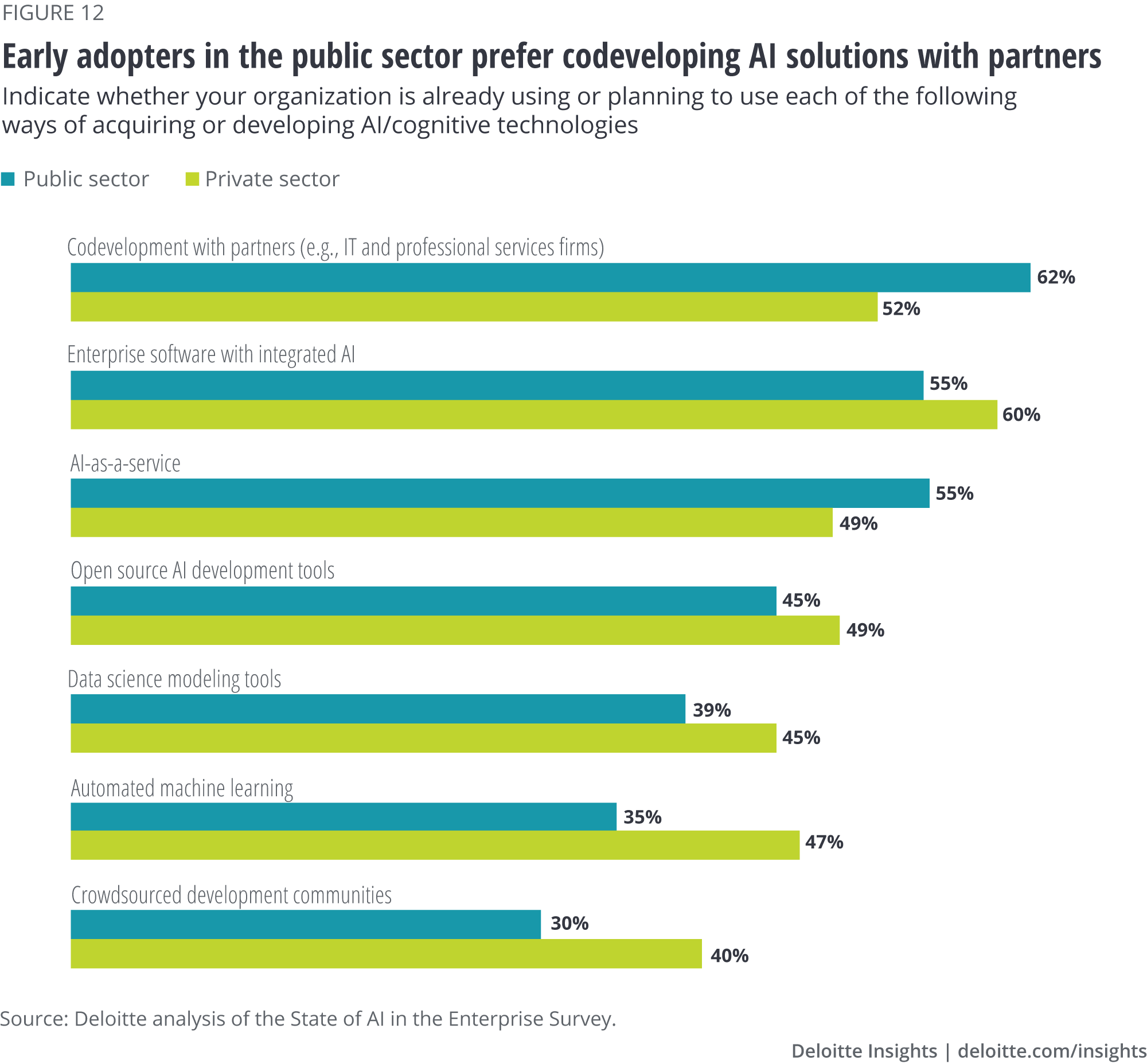
- Testing new approaches: To foster innovation, many early adopters surveyed in the public sector are experimenting with new technologies and building prototypes. Prototyping can help early adopters assess the vulnerabilities and test the impact of AI solutions in a controlled environment before they are scaled. Around 41 percent of public sector early adopter respondents said that their organization had tested more than five prototypes to date. In the US Department of Defense’s AI strategy, released in February 2019, prototyping is listed as one of the techniques to enhance the department’s AI capabilities.14
Learning from early adopters
The road to full-scale AI implementation may be a long one for many public sector agencies, but pilots, experiments, and AI initiatives in different pockets of government continue to grow. As more public sector agencies begin their AI journey, they should learn from the experiences of early adopters within the government, as well as their private sector counterparts, to identify the use cases that can be applied to their agencies and discover proven techniques to overcome challenges. With these learnings, the public sector can move up the AI adoption curve.
© 2021. See Terms of Use for more information.
-
Artificial intelligence in government Collection
-
AI-augmented government Article5 years ago
-
The rise of data and AI ethics Article5 years ago
-
How to begin regulating a digital reality world Article6 years ago
-
The future of work in government Article6 years ago
-
AI-augmented cybersecurity Article7 years ago













